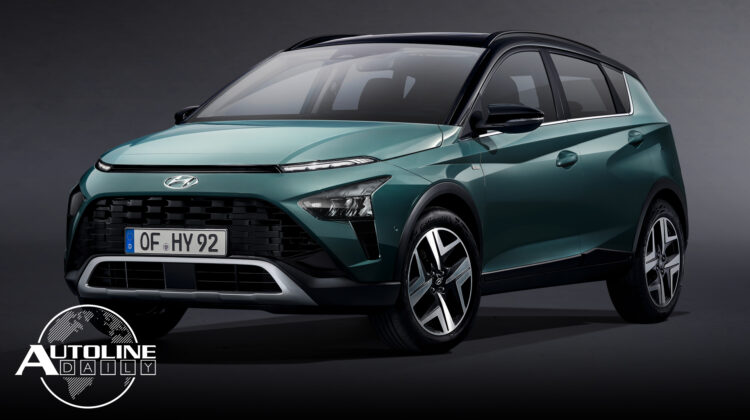
Listen to “AD #3028 – Hyundai Unveils New Bayon CUV; Car Sales Dip in February; Mazda CX-30 Turbo Impressions” on Spreaker.
Follow us on social media:
Runtime: 11:21
0:08 Mercedes-Benz Repurposes Engine Plant
0:57 Tesla to Update FSD Beta Next Month
1:31 Car Sales Dip in February
3:42 Autoline Stock Index Drops
4:08 Top Brands in China in January
4:39 Volvo C40 Recharge Very Similar to XC40 Recharge
5:29 Hyundai Unveils New Bayon CUV
7:24 Mazda CX-30 Turbo Impressions
9:15 Why IHS Markit Loyalty Study Is Best
Visit our sponsors to thank them for their support of Autoline Daily: Bridgestone, Intrepid Control Systems and Magna.
This is Autoline Daily, the show dedicated to enthusiasts of the global automotive industry.
MERCEDES-BENZ REPURPOSES ENGINE PLANT
We know the automotive world is going electric, so what do you do with an old manufacturing site that still makes internal combustion engines? Mercedes-Benz is taking its Berlin facility, which is the oldest site in its global powertrain network, and converting it into a place where it can test production processes it hopes to use in the future. The real benefit is that it will be able to develop, test and implement new software applications in a real environment, which includes things like predictive maintenance. It will also set up state-of-the-art pilot lines, test cells, use the facility for training and even make e-mobility components in the future. It’s an interesting idea for getting use out of a factory that otherwise might not be needed.
TESLA TO UPDATE FSD BETA NEXT MONTH
Tesla is making progress with its Full Self-Driving technology. On Monday, Elon Musk confirmed it will launch its subscription service for the package sometime in the second quarter. And now Tesla’s CEO says it will release a new version of its Full Self-Driving Beta software next month and that it will be made more widely available to customers. The company rolled out FSD Beta back in October but only to a select number of owners. Musk also said that the new version will be a big step towards full autonomy.
CAR SALES DIP IN FEBRUARY
Car shoppers tapped the brakes last month in the U.S. market. Sales slowed down noticeably. Of course, this is comparing sales to a year ago, and most states had not yet mandated shutdowns and quarantines. So it’s not too surprising to see a year over year drop. Let’s take a look at what did happen. Automakers sold 1.1 million vehicles, down 5%. The SAAR came in at 15.6 million versus 16.7 last year. Consumers bought 90,000 fewer passenger cars, down an alarming 25%. Light trucks were down by 79,500 units, off 7%. For almost every automaker it was a bad month, except for two. Tesla had a blowout month. Ward’s Intelligence reports it sold 10,000 cars up a stunning 63%. And Volvo was up almost 30%, with sales up across the entire lineup.
AUTOLINE STOCK INDEX DROPS
The stock market goes up, and the stock market goes down. And yesterday it went down–for automotive stocks, that is. The Autoline Stock Index fell 59 points, or 1.7%. But Ford had a decent day, up nearly 5%. Goodyear saw a nice pop of 4%. GM was up 3%, and so was Fisker. But just about everyone else was down.
| Autoline Stock Index | |||
|---|---|---|---|
| March 2, 2021 | |||
| Close | Change | % Change | |
| Total | 3,381.64 | -59.74 | -1.7% |
| Ford | $12.55 | +$0.57 | +4.8% |
| Goodyear | $18.10 | +$0.75 | +4.3% |
| GM | $54.11 | +$1.51 | +2.8% |
| Fisker | $28.25 | +$0.88 | +3.2% |
TOP BRANDS IN CHINA IN JANUARY
Which car companies are doing the best in China? LMC Automotive just published the best selling passenger brands there for January. Volkswagen tops the list, followed by Toyota, Changan, Honda and Geely. The only US brand that makes it into the top 10 is Buick which just squeezed in at the bottom of the list. By the way, this only includes passenger cars. If you add in light commercial vehicles, Changan moves ahead of Toyota.
| Brand | Sales | Market Share |
|---|---|---|
| Volkswagen | 208,000 | 10% |
| Toyota | 175,000 | 8% |
| Changan | 153,000 | 7% |
| Honda | 148,000 | 7% |
| Geely | 130,000 | 6% |
| Source: LMC Automotive | ||
VOLVO C40 RECHARGE VERY SIMILAR TO XC40 RECHARGE
The all-electric Volvo C40 Recharge got its full reveal around the same time yesterday’s show was going up and our description of a fastback version of the XC-40 is pretty spot on. Both ride on the CMA platform, but you’ll also notice a new front end design. Volvo calls the rear end ‘striking,’ but we’re getting some Aston Martin DBX vibes as well. Otherwise the XC40 Recharge and C40 are mostly similar; the C40 offers a twin motor setup that provides all-wheel drive, a 78-kWh battery pack and range comes to a WLTP estimate of 420 kilometers, which would be about 230 EPA miles. Production of the C40 Recharge kicks off this fall.
HYUNDAI UNVEILS NEW BAYON CUV
Check out Hyundai’s all-new compact crossover, called the Bayon that was designed specifically for Europe’s B-segment. There’s a couple of power choices: the base 1.2L engine makes about 80 horsepower and is paired to a 5-speed manual; while a 1.0L turbo comes in two power outputs. Both versions can be paired to a 6-speed manual or 7-speed DCT and 48-volt tech is available on the lower output engine, about 100 horsepower, while it’s standard on the nearly 120 horsepower version. The interior features a 10.25-inch instrument cluster and comes standard with a high-mounted 8-inch center display. There’s also a 10.25 center screen that is available. There’s a neat design element along the dash that extends the look of the air vents, which really draws your eye across the interior and the model seen here has a nice two-tone look as well. Exterior styling is adorned with many common design elements, like separated front lighting, shark fin rear pillar and floating roof. And look how much the front end looks like the old Kona. The rear is highlighted by two boomerang taillights, which sort of pinch the upper section together and are linked together with a thin lightbar. The new Bayon will be on sale in Europe soon.
Coming up next, John will be here to share his thoughts on the turbo version of the Mazda CX-30 and he has something to say about vehicle surveys.
MAZDA CX-30 TURBO IMPRESSIONS
A year ago we had the Mazda CX-30 come through the Autoline Garage, and you can watch what we had to say about it in Autoline Daily #2763. Recently, we had another CX-30 to test drive, but this one was the turbo and what a difference it makes. First let’s look at the numbers. The 2.5-liter turbo develops 227 horsepower. That’s 22% more horses than the naturally aspirated version. Torque for the turbo is 310 pound feet, up a whopping 68%. And here’s where the story gets even better. Those turbo numbers are based on using regular 87 octane gasoline. With 93 octane you get another 23 horses and 10 more foot pounds of torque. Mazda wanted owners to know that it’s fine to use regular if they want to, but it gave them something for their money if they splurged on premium. Yet, while these numbers are nice to look at, they don’t really tell the story. What’s more telling is how that power comes on. Peak horsepower develops at 1,000 fewer rpm than the naturally aspirated engine, and you reach peak torque at 2,500 fewer rpm, and even fewer still with premium fuel. That really transforms the way the car drives. It’s much more relaxing and easier to maneuver through traffic, or go for the gusto of spirited driving. It quiets the cabin and reduces vibration because you’re usually running at lower rpm. OK, now for the bad news. Mazda charges over $6,000 more for the turbo. That’s a healthy markup. But you get what you pay for and the CX-30 turbo is definitely a better car.
| Nat. Asp. 2.5 L | Turbo w/87 RON | Turbo w/93 RON | |
|---|---|---|---|
| Horsepower | 186@6000 | 227@5000 | 250@5000 |
| Torque | 186@6000 | 310@2500 | 320@2000 |
WHY IHS MARKIT LOYALTY STUDY IS BEST
When Consumer Reports rates the quality of cars, it surveys its own subscribers. So it’s really capturing the opinions of a universe of its own subscribers who fill out surveys. JD Power captures a wider audience, but it’s also capturing the opinions of car owners who fill out surveys. I’m not convinced those are statistically valid methods. And that’s why I like the IHS Markit loyalty awards.
Every year IHS Markit analyzes over 12 million new vehicle registrations to see what kind of car people had, and what kind of new car they went out and bought or leased. That allows Markit to measure which companies, brands and models have the highest loyalty. 12 million is a lot, and there are no surveys to fill out, so I like that methodology.
Guess which car companies have the highest loyalty? GM and Ford. They usually don’t do that well when CR or JD Power rate them. But having the highest loyalty speaks loud and clear about their quality. JD Power and Consumer Reports also rate Land Rover and Alfa Romeo at the bottom. But IHS Markit shows Land Rover has the highest loyalty with full size luxury SUV owners. And Alfa Romeo is the most improved. We’ve got the link to that study in our show notes if you want to dive down deeper into it.
Years ago the Packard Motor Company’s advertising slogan was “Ask The Man Who Owns One.” That’s kind of sexist way to state it today, but it’s also considered one of the most effective taglines in the history of automotive advertising.
And that wraps up today’s show, please join us again tomorrow.
Thanks to our partner for embedding Autoline Daily on its website: WardsAuto.com

John McElroy is an influential thought leader in the automotive industry. He is a journalist, lecturer, commentator and entrepreneur. He created “Autoline Daily,” the first industry webcast of industry news and analysis.






